Students can access the CBSE Sample Papers for Class 12 Biology with Solutions and marking scheme Term 2 Set 3 will help students in understanding the difficulty level of the exam.
CBSE Sample Papers for Class 12 Biology Standard Term 2 Set 3 with Solutions
Time Allowed: 2 Hours
Maximum Marks: 40
General Instructions:
- All questions are compulsory.
- The question paper has three sections and 13 questions. All questions are compulsory.
- Section-A has 6 questions of 2 marks each; Section-B has 6 questions of 3 marks each; and Section-C has a case-based question of 5 marks.
- There is no overall choice. However, internal choices have been provided in some questions. A student has to attempt only one of the alternatives in such questions.
- Wherever necessary, neat and properly labeled diagrams should be drawn.
SECTION – A
(Section A has 6 Questions of 2 marks each.)
Question 1.
(A) During a discussion on biodiversity, the
teacher showed the following picture of Amazon rainforest and labelled it as Lungs of the Planet. Why Amazon rainforest are termed as ‘Lungs of the Planet’?
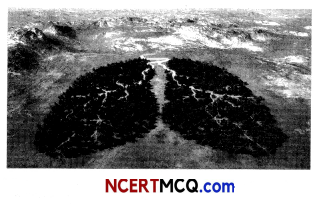
(B) Name any two biodiversity hotspots of India. (2)
Answer:
(A) Among all the rainforests found on Earth, the largest one is Amazon rainforest. In Amazon rainforest, billions of tree and plant species are present. They take in tonnes of carbon dioxide and converts it to oxygen. This rainforests contributes about 18% to 20% of the world oxygen. Thus, they are considered as the lungs of the planet.
Related Theory
Rainforests refer to those forests where there is continuous rainfalL It constitute some of the globe’s most important ecosystems and environments. The globe’s rainforests cover nearly 2% of the earth’s total surface area and host more than 50% of the world’s animals and plants.
(B) The two biodiversity hotspots of India are:
- Western Ghats and Sri Lanka
- Indo-Burma
- Himalaya (Any two)
Question 2.
(A) Reema was buying vegetables from the
supermarket and she noticed one of the labels as GM foods. What do you mean by GM foods?
(B) Many multinational companies use bioresources without authorization from the concerned country and its people.
What is this practice called? (2)
Answer:
(A) Genetically modified (GM) foods are defined as the foods that are derived from organisms whose genetic material (DNA) has been manipulated by incorporating a gene that will express a desirable trait.
Related Theory
The organisms in which DNA is manipulated are known as genetically modified organisms/transgenic/ genetically engineered.
(B) The practice of exploiting the bioresources by the multinational companies and organizations without authorization from the concerned country and its people is called as Biopiracy.
![]()
Question 3.
What is the role of microbes in producing the following types of cheese?
(A) Swiss cheese
(B) Roquefort cheese
OR
Why eradication of insect pests is not recommended by organic farmers? (2)
Answer:
(A) ‘Swiss cheese’: in this kind of cheese the
large holes are formed due to production of a large amount of CO2 by a bacterium named Propionibacterium shermanii.
(B) ‘Roquefort cheese’: are ripened by growing a specific fungus known as Penicillium roqueforti on them, that gives them a particular flavour.
OR
Organic farmers believe that ‘biodiversity furthers health’. They do not recommend eradication of insect pests because in their absence the beneficial predatory and parasitic insects that depend on them as food or hosts would not be able to survive.
Related Theory
Organic farming requires the knowledge and understanding of various life forms present in the field such as predators, pests, their life cycles, patterns of feeding and the habitats that they prefer, so that they can be used in biocontrol measures. Ultimately, this will greatly reduce our dependence on toxic and harmful chemicals and pesticides.
Question 4.
The given diagram shows the release of histamine near an injury site in the body. Discuss the role of histamine in inflammatory response.
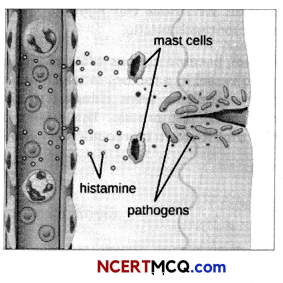
Explain the role of lymph nodes (secondary lymphoid organs) in our immune system. 2
Answer:
Histamine is released by basophils and mast cells as a part of local immune response in order to cause inflammation. Histamine is an organic nitrogenous compound. Release of histamine causes the capillaries to become more permeable to the WBCs and as a result they attack the foreign bodies in the affected areas. Therefore, histamine causes inflammation so that other chemicals are also released out and help in the repair work.
OR
Lymph nodes are small solid structures that are present at different points along the lymphatic system. The function of the lymph nodes is to trap the microorganisms or other antigens that enters the lymph and tissue fluid. As a result, the antigens that are trapped in the Lymph nodes, bring about the activation of lymphocytes present there and thus elicit the immune response.
Related Theory
Secondary lymphoid organs are the sites where interaction of lymphocytes with the antigen takes place, which then proliferate and develop to become effector cells.
![]()
Question 5.
(A) Ruminant animals like cattle harbour methanogens in their rumen (a part of their digestive tract). What is the function of these methanogens?
(B) How Lactobacillus bacteria improve the nutritional quality of curd? (2)
Answer:
(A) Methanogens (anaerobic microbes) help in the digestion of cellulose in the rumen of the cattle.
(B) Lactobacillus bacteria improve the nutritional quality of curd by increasing the amount of a nutrient, Vitamin B12.
Question 6.
Tobacco smoking is very harmful for the person’s health as it leads to severe consequences like oxygen deficiency in blood. How does tobacco smoking lead to oxygen deficiency in human body? (2)
Answer:
There is an increase in the content of carbon monoxide (CO) in the blood of the person who smokes tobacco. CO has greater affinity to haemoglobin than oxygen and forms a stable bond with haemoglobin and does not allow oxygen to bind. This results in reduction of oxygen carrying capacity of haemoglobin. As a result, this reduces the content of haemoglobin bound oxygen and leads to oxygen deficiency in human body.
Related Theory
Due to tobacco smoking less oxygen reaches the mind, heart, muscle tissue and different organs. Therefore, lung function is reduced due to the narrowing of the lung airways and extra mucus in the lungs. Smoking also damages alveolar walls, which reduces respiratory surface (emphysema).
![]()
SECTION – B
(Section B has 6 Questions of 3 marks each.)
Question 7.
(A) The following picture shows the roots of a tobacco plant infected with nematode MeLoidogyne incognita, which decreases the yield and quality of tobacco plants. How the nematode infection in the roots of tobacco plants controlled with the process of RNA interference?
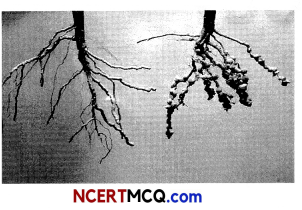
(B) A cow named “Rosie” was a transgenic cow. Why it is considered to be different from a normal cow?
OR
Enlist any three transgenic organisms and their application. 3
Answer:
(A) In the technique of RNA interference or gene silencing, nematode specific genes/ DNA is introduced in the host plant. This DNA then produces two types of RNA – sense and anti-sense RNA. As a result, these two strands of RNA, binds with each other to form a double-stranded RNA as they both are complementary to each other in sequence. Since dsRNA cannot translate, as a result, its expression is blocked and thus it leads to RNA interference. Therefore, the mRNA of nematode is silenced and the parasite cannot survive in the transgenic host.
Related Theory
The roots of tobacco plants are infected by a nematode Meloidogyne incognita.
(B) The transgenic cow “Rosie” do not produce only normal milk like other cows, but it produced human protein-enriched milk (2.4 g/L). Human alpha-lactalbumin was present in the milk and was nutritionally a more balanced product for human babies than natural cow-milk.
Related Theory
Rosie was the first transgenic cow created in 1997.
Caution
Students should remember that Rosie was the first transgenic cow, but the first transgenic animal was a mouse. Almost 95% of all transgenic animals are mice. These transgenic mice are developed for the purpose of studying human physiology and development.
OR
Following table shows the transgenic organisms and their application;
| Transgenic organism | Application |
| Flavr Savr Tomato | This transgenic variety of tomato have increased shelf life due to delayed ripening and better nutrient quality. |
| Bt Cotton | The transgenic cotton plant is pest resistant, herbicide tolerant and gives high yield. |
| Cattles (cow, sheep, goat) | The transgenic animal produces therapeutic human proteins in their milk. |
Question 8.
A hypothesis was proposed to explain the importance of biodiversity for survival of species. Who gave this hypothesis? Explain the hypothesis briefly. (3)
Answer:
Paul Ehrlich, a Stanford ecologist, gave ‘rivet popper hypothesis’ to explain the importance of biodiversity for survival of species.
- In his hypothesis, he considered the ecosystem as an airplane, in which all parts are joined together using thousands of rivets (species).
- If every passenger, travelling in it, starts popping a rivet to take home (causing a species to become extinct), it may not affect flight safety (proper functioning of the ecosystem) initially, but as more and more rivets are removed, the plane becomes dangerously weak over a period of time.
- Also, which rivet is removed may also be critical. For example, loss of rivets on the wings (key species that drive major ecosystem functions) is obviously a more serious threat to flight safety than loss of a few rivets on the seats or windows inside the plane.
![]()
Question 9.
Akshat became curious after seeing a very large vessel in a factory in which millions of microorganisms were cultured to produce a recombinant protein. The scientists told him that it was a bioreactor. Can you define bioreactor for him? Also, list the various components of a bioreactor. (3)
Answer:
To produce the cloned gene of interest on a large scale, the large volume vessels called as bioreactors, having a capacity of approximately 100-1000 liters are used, in which raw materials are biologically converted into specific products, individual enzymes, etc., using microbial plant, qnimal or human cells. The various components of a bioreactor are:
- Agitator system
- Oxygen delivery system
- Foam control system
- Temperature and pH control system
- Sampling port to withdraw periodically.
Related Theory
A bioreactor provides the optimal conditions for producing the desired product by providing optimum growth conditions like temperature, pH, substrate, salts, vitamins and oxygen.
Question 10.
An instructor showed a slide to students depicting Anabaena and a picture of mycorrhiza, both of which act as biofertilisers. How do Anabaena and mycorrhiza act as biofertilisers? (3)
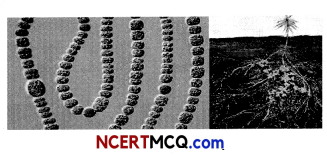
Answer:
Fungi form symbiotic associations with plants which are known as mycorrhiza. In such associations, the fungal symbiont absorbs phosphorus from soil and transfers it to the plant. Many members of the genus Glomus form mycorrhiza.
Cyanobacteria are the autotrophic microbes that are found in aquatic and terrestrial environments. Many of them can fix atmospheric nitrogen, for example: Anabaena, Nostoc, Oscillatoria, etc., and serve as an important biofertilizer in paddy (rice) fields. Cyanobacteria also add organic matter to the soil and thereby increases its fertility.
Related Theory
Biofertilisers are organisms which enrich the nutrient quality of the soil by increasing the availability of nutrients to the crops.
![]()
Question 11.
(A) Give reasons for the following:
- Enzyme cellulose is needed to isolate genetic material from plant cells and not from animal cells.
- Exonuclease are not used for creating a recombinant DNA molecule.
(B) Who were responsible for the synthesis of first recombinant DNA molecule and in which year? (3)
Answer:
(A) (i) The plant cell wall is made up of cellulose, therefore, in order to digest cellulosic cell wall the enzyme cellulose is used, whereas the animal cells lack a cell wall and thus they do not need this enzyme.
(ii) Exonucleases are not used for creating rDNA molecule because they only remove the nucleotides from the ends of DNA molecule and not at any particular desired site/region within DNA.
(B) In 1972, Stanley Cohen and Herbert Boyer synthesized the first recombinant DNA molecule.
Question 12.
Classify the following diseases as infectious diseases and non-infectious disease. Also mention the basis of your classification. (3)
(a) Scurvy
(b) Cancer
(c) Syphilis
(d) AIDS
Answer:
Infectious diseases – Syphilis, AIDS
Non-lnfectious diseases – Scurvy, Cancer Basis of classification: Infectious diseases are those diseases that are easily transmitted from one person to another via pathogens. Non- infectious diseases are those which cannot be transmitted from one person to another and are not caused by pathogens. The cause of such diseases are nutritional deficiencies, malfunctioning of organs, etc.
Related Theory
Since infectious diseases are transmitted from one person to another via pathogens, such as, the cause of Syphilis is a bacterium called Treponema pallidum and AIDS spreads through Human Immunodeficiency Virus (HIV).
Caution
In case of non-infectious diseases, pathogens are do not play any role, such as Scurvy is caused by Vitamin C deficiency and cancer is caused by Oncogenic transformation of cells due to carcinogens such as X-rays, UV rays, etc.
![]()
SECTION – C
(Section C has a case-based question of 5 marks.)
Question 13.
The given picture depicts an animal named kangaroo rat that seldom drinks water. It has a thick coat to minimise evaporation and rarely comes out of its humid and cool burrow during day time. 90% of its water requirement is met by metabolic water which is produced by respiratory breakdown of fats whereas 10% is obtained from the food. It conserves water by producing almost solid urine and faeces.
Based on this answer the following questions:
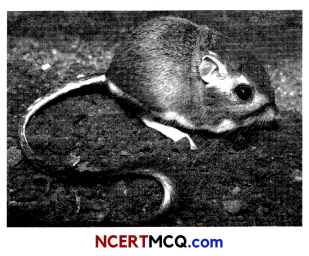
(A) Kangaroo rats live in deserts, which are very hot and dry. How does the kangaroo rat get the water it needs?
(B) Due to the adaptations shown by Kangaroo rat, it is said to be a regulator. Justify the statement by defining it.
(C) Kangaroo rat is able to perform homeostasis. How would you define homeostasis?
(D) List any two adaptations of kangaroo rat that helps it to survive in a hot and dry climate.
OR
The teacher presented the following two pictures to her students in order to make them understand about the carrying capacity of a population.
Based on this answer the following questions:
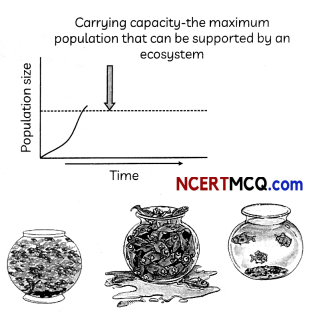
(A) Which factors are responsible for decreasing the density of a population in a given habitat?
(B) Which growth curve is followed by human population?
(C) What does niche overlap indicates?
(D) Differentiate between immigration and emigration. (5)
Answer:
(A) Kangaroo rat get the water from the seeds it eats.
Explanation: Kangaroo rats get the water they need from food. They eat mostly seeds. 90% of its water requirement is met by metabolic water which is produced by respiratory breakdown of fats whereas 10% is obtained from the food.
(B) Kangaroo rat is a regulator because it performs homeostasis with the help of thermoregulation and osmoregulation by behavioural changes and physiological adjustments.
![]()
(C) Homeostasis is the process by which the organisms try to maintain the constancy of its internal environment despite varying external environmental conditions.
(D) The kangaroo rat is adapted to desert Life. The adaptations are as follows:
(i) They can survive without drinking water, by getting moisture from their fatty seed diet.
(ii) Produce concentrated urine and do not use water for regulation of body temperature.
OR
(A) The factors that are responsible for decreasing the density of a population in a given habitat are mortality and emigration.
(B) S-shaped growth curve is followed by human population.
(C) Niche overlap indicates that there is sharing of one or more resources between the two species.
(D)
| Immigration | Emigration |
| It can be defined as the number of individuals of the same species that have entered into the habitat from outside during the time period under consideration. | It is defined as the number of individuals of the particular population who left the habitat and moved elsewhere during the time period under consideration. |